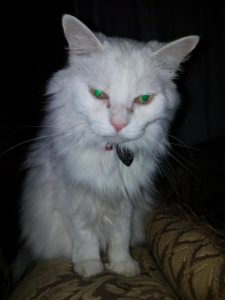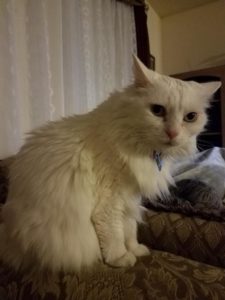What Is That Lump On My Cat’s Neck?

A friend of mine reached out to me last week because she discovered a small lump on the back of her cat’s head. It felt soft and didn’t seem to bother Vanilla except when she was being brushed in that area. Was it something she needed to worry about? How could she get rid of it? Diving in to do some research on this I remembered that Dr. Karen Becker, DVM, did an article on this topic awhile back. These lumps are called lipomas and are non-cancerous fatty masses, and they’re mostly found in pets who have a problem with metabolism. Fatty lipomas in cats are a warning sign that something is not functioning correctly.
Causes of Fatty Lipomas
The first thing you have to address when it comes to lipomas is why the metabolism isn’t functioning at optimal levels. According to one article, lipomas are
a sign the body is trying to get rid of unwanted material but because it is out of balance it cannot process this unwanted material through normal channels (kidneys, liver, intestines, etc.). Since the endocrine (glandular) and immune systems are usually not functioning at 100%, the body does the next best thing and tries to encapsulate this unwanted material and get it out of the way through the largest excretory organ of the body, the skin. It’s like sweeping the dirt underneath the rug when you don’t know what to do with it. The fatty tumor (lipoma) is that lump of dirt under the rug (skin).
While your vet may or may not choose to remove them, it’s important to remember that treating the cause is paramount to your cat’s health. Removing them just treats the symptom. The three major organs that remove waste from the body are the intestines, liver and kidneys, and the endocrine system plays an important role in metabolism. All the glands and organs in the body work synergistically in order to produce a well-balanced system. If one body system is sluggish or not working optimally it will affect the entire body. This is why it’s important to treat the whole body and not try to put a band-aid on only one organ, etc. The ultimate goal of a holistic health approach is to bring about homeostasis in the body. When the cells in the body don’t work properly the result is disease, and this is a direct result of nutrient deficiency and toxicity.
The Link Between Diet, Nutrient Deficiency and Toxicity

Vanilla
In Vanilla’s case I was able to muscle test to determine that her liver and endocrine system were impaired. After speaking with her owner further it became apparent that her diet was the ultimate problem. She is addicted to kibble and loves eating the cheap, unhealthy cat food instead of a high quality meat-centered, grain and carb-free diet. Vanilla also has a history of diabetes which really puts her at greater risk for health issues. The food she loves has made her body toxic and has impaired the ability of the cells in her body to function normally. It’s also left her body nutrient deficient. As a result her body is trying to detox itself through the largest organ her body has: the skin. The result is a fatty lipoma.
Often times if the diet is improved health conditions can be improved and even reversed. For Vanilla’s owner this has to be the number one priority, followed by some endocrine and liver supplements to help support and cleanse her system. I found a great set of products that provide support for the endocrine system, detox the liver, build the immune system, stimulate metabolism, and support skin and coat health: Adrenal Super Support and Nutritional Balance Kit by NHV Naturals. Muscle testing revealed this kit was perfect for Vanilla! These supplements are additive and preservative free and are made from 100% natural organic or ethically harvested herbs. Unlike pharmaceutical drugs they work naturally with the pet’s body and are free of toxic chemicals that produce unwanted side effects.
Make The Switch
I understand that kibble-addicted cats can be quite the challenge for cat parents, and changing their diet will be an uphill climb if not a battle. Persistence and patience is the key! Try offering premium canned food or lightly cooked homemade food as treats or alongside or mixed with the kibble. Try freeze-dried food crumbled as toppers. Fish varieties can be very appealing to finicky eaters, too. To learn more about transitioning your cat to a more appropriate diet check out this article. Whatever you do, don’t give up–your cat’s health and longevity literally depends on it!
Help spread the word about holistic health for cats by sharing this article on your favorite social channel! Sign up here to follow all our posts.

